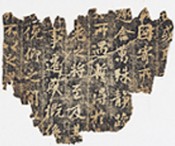
World culture: Unique works by Japanese master of calligraphy are presented in Tokyo
The National Museum of Tokyo on January 22, 2013 will open an exhibition dedicated to the Chinese calligraphy master of the IV century Wang Xizhi, nicknamed "God of Calligraphy". According to Agence France-Presse, it will present a newly discovered copy of his work, dated by VII-VIII century.
The rarity of this finding is due to the fact that up to now it has not survived a single original works of the Chinese master, which was highly appreciated during his lifetime, and the replicas help to investigate his letter. In addition, copies, modeled on Wang Xizhi, the last time were found about forty years ago.
The work size 26 to 10 centimeters is owned by a Japanese collector, whose name was not disclosed. It includes 26 hieroglyphs, which are arranged in three lines. The researchers suggest that this is a piece of the letter of Wang Xizhi: it includes expressions which, as you know, he used.
Most copies of Wang Xizhi are over a thousand years; some of them are stored in Japan and are considered a national treasure. It is assumed that the copy came to Japan in the VII-VIII century as a result of trade or diplomatic missions of the Chinese.
The exhibition, dedicated to Wang Xizhi and his influence to the following generations of calligraphers, will run until March 3.

